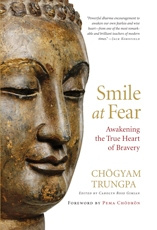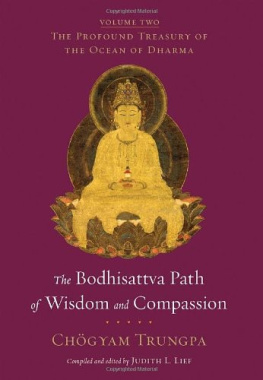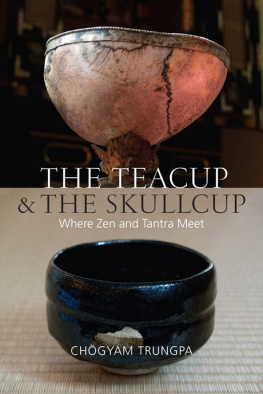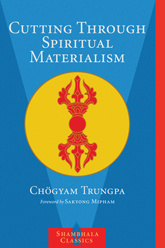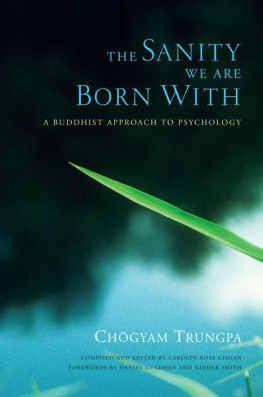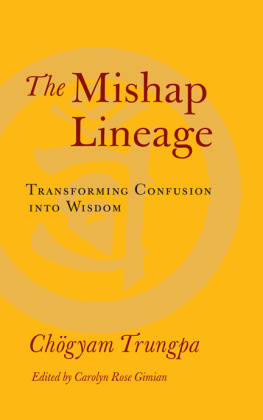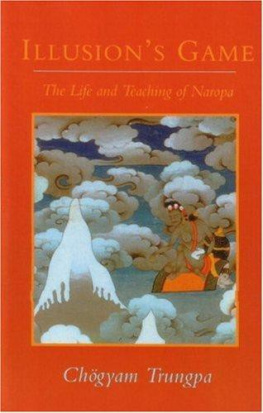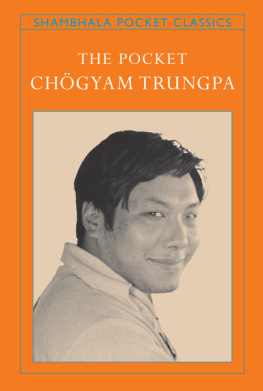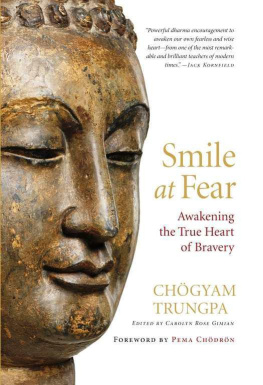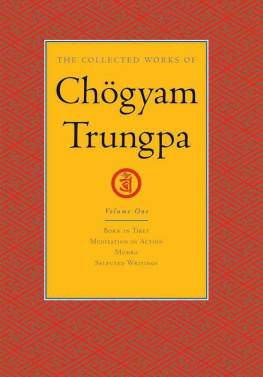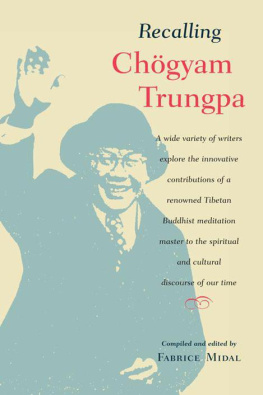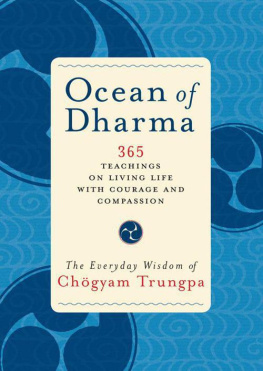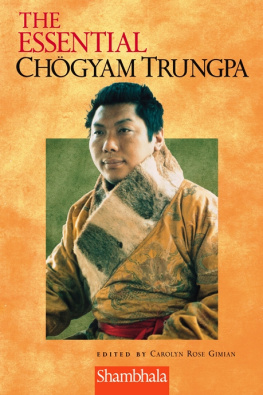All is made painfully clearwe are routed out of our little cubby holes, all of our excuses are brought out into the open and exposed for what they are.... If it is reality you want and not illusion, this is it.... An ego-shattering experience.
The Middle Way
ABOUT THE BOOK
Chgyam Trungpas unique ability to express the essence of Buddhist teachings in the language and imagery of modern American culture makes his books among the most accessible works of Buddhist philosophy. Here Trungpa explores the true meaning of freedom, showing us how our preconceptions, attitudes, and even our spiritual practices can become chains that bind us to repetitive patterns of frustration and despair. This edition features a new foreword by Pema Chdrn, a close student of Trungpa and the best-selling author of When Things Fall Apart.
CHGYAM TRUNGPA (19401987)meditation master, teacher, and artistfounded Naropa University in Boulder, Colorado, the first Buddhist-inspired university in North America; the Shambhala Training program; and an international association of meditation centers known as Shambhala International. He is the author of numerous books including Shambhala: The Sacred Path of the Warrior, Cutting Through Spiritual Materialism, and The Myth of Freedom.
Sign up to receive inspirational quotes by Chgyam Trungpa and special offers from Shambhala Publications.

Or visit us online to sign up at shambhala.com/eoceanofdharma.
The Myth of Freedom
and the Way of Meditation

C HGYAM T RUNGPA
EDITED BY
John Baker and Marvin Casper
ILLUSTRATED BY
Glen Eddy
FOREWORD BY
Pema Chdrn

S HAMBHALA
Boston & London
2010
This book is dedicated to Dorje Trllo, the Crazy Wisdom form of Padmasambhava, the father and protector of all beings.
SHAMBHALA PUBLICATIONS, INC.
Horticultural Hall
300 Massachusetts Avenue
Boston, Massachusetts 02115
www.shambhala.com
1976 by Chgyam Trungpa
Illustrations 1976 by Shambhala Publications, Inc.
Foreword 2001 by Pema Chdrn
All rights reserved. No part of this book may be reproduced in any form or by any means, electronic or mechanical, including photocopying, recording, or by any information storage and retrieval system, without permission in writing from the publisher.
The Library of Congress catalogues the previous edition of this book as follows:
Trungpa, Chgyam, 1939
The myth of freedom and the way of meditation/
Chgyam Trungpa; foreword by Pema Chdrn
p. cm.
Previously published: C1976
eISBN 978-0-8348-2141-5
ISBN 1-57062-933-1
ISBN 1-59030-289-3
1. Spiritual lifeBuddhism 2. Meditation (Buddhism)
I. Title. II. Series.
BQ7805.T78 2002
294.344DC21
2001054983
CONTENTS
ILLUSTRATIONS
. His Holiness the XVI Gyalwang Karmapa. Gyalwang Karmapa is the supreme head of the Kagy order of Tibetan Buddhism. He is the embodiment of the power and compassion of Buddhist tantra. He currently resides at Rumtek Abbey in Sikkim, India. He was a friend and inspiration to the author.
. Milarepa with Vajrayogini above his head. Milarepa, one of the founding fathers of the Kagy lineage, is renowned for having attained enlightenment in one lifetime. His life serves as an example of the approach of the yogi in Tibetan Buddhism, combining asceticism with devotion. Thus his followers are known as Kagypas, the practicing lineage. Above his head is Vajrayogini who represents the feminine aspect of ones innate nature and the clarity gained from discriminating awareness. The Vajrayogini principle plays an important role in the Kagy tradition.
. Four-armed Mahakala. Described in the section "Working with Negativity," in chapter 4.
. Klong-chen rab-byams-pa (Longchenpa) with Shri Singha above his head. Longchenpa was a great teacher of the Nyingma lineage of Tibetan Buddhism. He is known for systematizing the oral teachings of this lineage. Shri Singha was an Indian master of the highest teachings of tantra. He was a teacher of Padmasambhava, who brought the buddha-dharma to Tibet.
. Vajradhara. The Buddha manifests himself as Vajradhara to expound the teachings of tantra. He is also the supreme buddha expressing the whole of existence as unborn and unoriginated. The tantric practitioners personal teacher is identified with Vajradhara. He is the source of several important lineages of Buddhism in Tibet.
. Mandala of the five buddha-wisdoms. These are the basic attributes of how enlightened mind perceives and manifests in the phenomenal world through the manner of the five wisdoms: wisdom of all-encompassing space, mirror-like wisdom, wisdom of equanimity, discriminating-awareness wisdom, and wisdom of accomplishing all actions.
. Ekajati with Samantabhadra above her head. Ekajati is a protectress of the dharma and guide to the masters of tantric teachings. She is a destroyer of those who pervert the true meaning of the dharma. Samantabhadra is the primordial buddha who represents the final state of wakefulness.
FOREWORD
I N 1972 I was teaching at an alternative school in New Mexico. I introduced my class of eight- to twelve-year-olds to a book called Born in Tibet and we all fell in love with it. When we learned that the author, Chgyam Trungpa Rinpoche, was living in Boulder, Colorado, the children wrote a letter asking if they could meet him. Rinpoche replied that in fact he was soon coming to teach at the nearby Lama Foundation. To our delight, we were invited to visit him there. When we arrived, one of Rinpoches students met with us briefly. He told the children that Chgyam Trungpa was happy that we had come, but that he wanted the children to know that he was just an ordinary person, nothing special. With plenty of questions and handmade gifts, the children approached him, and they had a wonderful encounter. Three hours later, they returned home. As for me, I guess you could say that I never left. That is when I became the student of this ordinary extraordinary man.
When The Myth of Freedom was published a few years later, I read it over and over. It is a profound distillation of Buddhist truths expressed in the accessible style of a master adept at translating them into the language of his audience. I was extremely eager to digest what he was saying. Over the years, this book has continued to be an endless source of benefit to me and many others in our understanding and teaching Buddhism in North America. I think I have now read it at least twenty times, and each time I find something new. Its power lies in how directly it addresses the extremely unhabitual process of dissolving the barriers we put up between ourselves and the rest of the world.
When I took to heart the teachings presented here, a curious change slowly began to take place. I became far more open to the pain of myself and others; far more open to laughing and crying; far more able to love and accept and see my interconnectedness with all beings. As the years go by, I gradually become more and more at home in this world with its inevitable ups and downs.
It is in this spirit that I invite you to read the teachings presented here. If you too bring them into your life and put them into practice, I have no doubt that you will make a similar journey.
As my root teacher, the Vidyadhara Chgyam Trungpa Rinpoche vividly demonstrated this path to me, he also supported and encouraged me in following it. I feel glad that I can now encourage you and those who come after you to do the same. Thanks to the teachings of Chgyam Trungpa Rinpoche, ordinary people like you and me can do something extraordinary: we can learn to benefit all beings, including ourselves.
Next page
